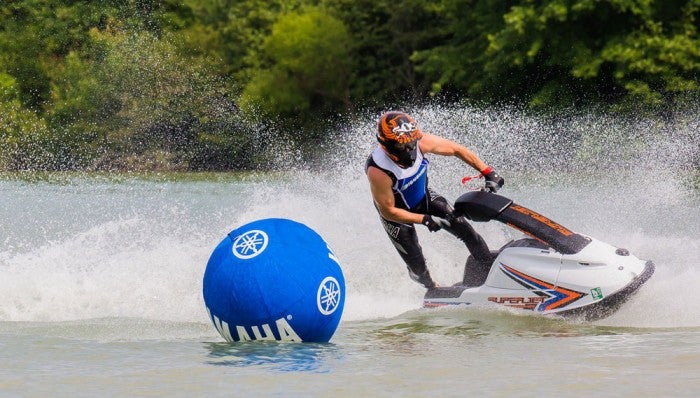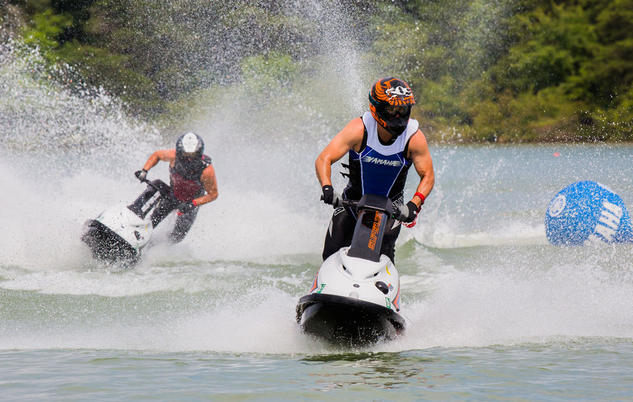2016 Yamaha SuperJet Review
A throwback standup personal watercraft
By now, many consumers realize the days of the standup are almost gone. Kawasaki exited the solo ride market years ago. Yamaha keeps plugging along, but emissions laws mean its two-stroke powered SuperJet is for sale “for closed course competition use only.”
In short, they’re for sale to racers, who plan to use them for racing, on designated race courses. That two-stroke engine prevents the craft from being bought and registered for use on normal waterways by normal everyday consumers.
So why waste the space reviewing something that’s been reviewed so many times before? Because, technically Yamaha produces a SuperJet model with a 2016 model year. And technically, there are some of you out there carrying competition licenses who will likely be able to find a place to ride them.
 If you buy a new Yamaha SuperJet it is meant for competition use only. However, older SuperJets can be ridden anywhere a runabout can.
If you buy a new Yamaha SuperJet it is meant for competition use only. However, older SuperJets can be ridden anywhere a runabout can.But also because there are some of you who should maybe consider buying a used SuperJet (grandfathered in under the rules), registering it, and enjoying it for recreational use.
Stand Up And Be Counted
Why? Because riding a standup is pure fun. Because it’s what the industry essentially sprang from, a throwback to the days when fun factor trumped ease of use 100 fold. And because, well, it’s a challenge.
COMPARISON: Read our review of the 2011 Kawasaki Jet Ski 800 SX-R
I’ve taught countless people to ride standups over the years, and despite the falls and frustrations in the early going, all have been thrilled to actually succeed at getting up, then eventually making that first turn. Standups keep your interest precisely because they have a learning curve. They’re a workout, they allow you to keep progressing, and they reward the time invested with the most agile and responsive personal watercraft on the water. With practice your turns will become tighter and sharper, your jumps bigger and higher, your freestyle moves cooler and more complex. You won’t need to go for longer rides when things get boring; you can have a blast just challenging yourself to learn that new trick within sight of the beach.
 Standup PWC are designed for fun. While you can still get going at a pretty good speed, standup pilots prefer carving tight turns and trying out new tricks.
Standup PWC are designed for fun. While you can still get going at a pretty good speed, standup pilots prefer carving tight turns and trying out new tricks.A standup is also relatively inexpensive, light enough to carry to the water with a friend or two, small enough to fit in the back of a pickup…the list goes on and on.
So that’s my brief sales pitch. Now let’s get on with the review.
Perfect Balance
One of the keys to the SuperJet’s long-term success is its design and engine package, a combo that has been fine-tuned over literally decades of production.
 Thanks to its light weight and compact dimensions, you can flick the SuperJet into some crazy lean angles.
Thanks to its light weight and compact dimensions, you can flick the SuperJet into some crazy lean angles.At roughly 88” x 27” and just over 300 pounds, the seemingly final version of the SuperJet retains an old-school standup’s smaller dimensions, making it feel light and playful. A rider can dictate a lot of the craft’s movement through leaning and shifting body weight, dragging a leg through a corner or dropping their butt toward the water’s surface. The hull, however, is new-school all the way. It adopts a race-proven formula, wider forward, slimmer aft, and with sharp chines to rail around a slalom course, blast a spray-producing turn, or launch into aerial freestyle maneuvers. The pump is pushed far to the stern to enhance the craft’s agility. Along with an extended rideplate, the pair further enhances the boat’s reflexes, acceleration and top-speed stability.
COMPARISON: Read our review of the 2016 Sea-Doo Spark
The pilot’s control of the craft is impressive. The HydroTurf-covered tray features a raised kick tail to wedge a foot against for added leverage. The handle pole is spring-loaded to take some weight off the lower back. You can even fiddle with the steering cable connection at the handlebars to quicken the craft’s response.
 A spring-loaded handle pole makes it easier to hold up, relieving stress from your lower back.
A spring-loaded handle pole makes it easier to hold up, relieving stress from your lower back.As to that engine, yes it’s a two-stroke. But it’s a nearly bulletproof two-stroke, Yamaha’s long-running 701cc engine with dual 38mm carburetors. Linked to a 144mm diameter jet pump, it produces impressive thrust out of the hole as well as power deep into a turn. On the top end, expect to peak in the mid 40 mph range (about 45), and know that plenty more power awaits if you turn to the aftermarket. Still, you might be surprised just how fast 45 mph can feel on such a narrow craft you’re forced to balance rather than just sit atop.
And I’m betting most standup enthusiasts don’t straight-line drag race all that often. Carving and freestyle riding are just so much more fun.
Something Old, Something New…
Though the Yamaha SuperJet hasn’t changed in years, there is an update for 2016. Rather than just carry the craft along, Yamaha chose to freshen up its look this season, offering two versions – one in white with orange and black, and one in white with just black. They stand out from the craft of years past…
…as will you, if you commit to breaking from the sit-down pack.
| 2016 Yamaha SuperJet Specs | |
| Length | 88.2 inches |
| Beam | 26.8 inches |
| Dry Weight | 306 lbs |
| Engine | Twin cylinder, two-stroke |
| Displacement | 701 cc |
| Bore and Stroke | 81mm x 68 |
| Compression Ratio | 7.2:1 |
| Rated Horsepower | N/A |
| Fuel Capacity | 4.8 gal. |
| Colors | Pure White w/Orange & Black; Pure White w/Black |
| Price | $8,499 |
Get PersonalWatercraft.com in your Inbox!
Like PersonalWatercraft.com on Facebook
Comments
Most Popular

2025 Yamaha JetBlaster PRO 2-Up Review

Remembering the Sea-Doo XP

2024 Kawasaki Jet Ski STX 160X Review

Whatever Happened to the Wetbike?

2017 Kawasaki Jet Ski Ultra 310LX Review















 Your Privacy Choices
Your Privacy Choices